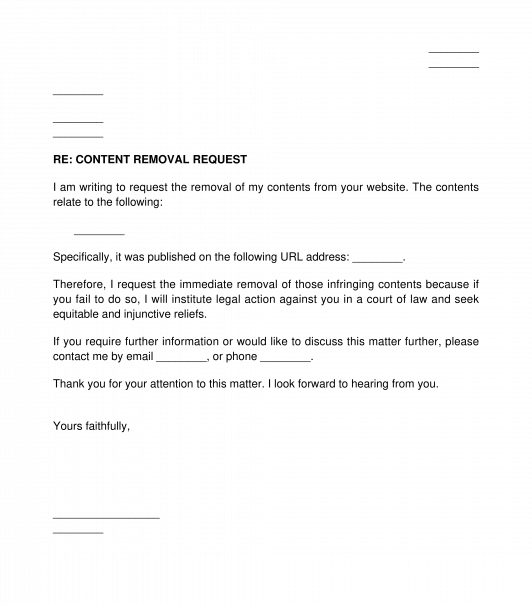 09/09/2025
09/09/2025

Answer a few questions and your document is created automatically.

Your document is ready! You will receive it in Word and PDF formats. You will be able to modify it.

 09/09/2025
09/09/2025
 Word and PDF
Word and PDF
 1 page
1 page



A Content Removal Request Letter is a document by which the owner of an original work can request the removal of any content that has been published or posted without the owner's consent. This letter serves as a notice to the recipient that the material or content they have posted on their website, mobile app, or other platform violates the intellectual property rights of the owner of the work.
Intellectual property refers to the intangible property and rights acquired by a person as a result of their creativity, such as patents, copyright, trademark, trade name or logo, trade secrets, and so on. The creator or owner of intellectual property has the sole right to use and grant permission to anyone use their intellectual property. Consequently, if a party desires to use the intellectual property of another, that party must first seek the approval of the owner or originator as any unauthorized use constitute an intellectual property right infringement.
This letter applies to the following forms of intellectual property right infringement:
This document is different from the Cease and Desist Letter, which is used where the infringing party is warned to stop and discontinue their violation or face legal actions. This notice simply requires the recipient to take down a copyrighted material that has been posted without the permission of the copyright holder. However, if the recipient willfully refuses to comply, the sender can issue the Cease and Desist Letter.
How to use this document
This a short and simple document, which requires the following information: the name and contact details of both the sender and the recipient, a description of the content that was posted, and details of where the content is hosted.
After completing this document, the sender should sign it and deliver it to the individual or organization that has posted the content. If the sender is an organization, an authorized representative of the sender organization should sign the document on its behalf. Alternatively, this notice can be sent as an email.
The sender is also required to keep a copy of this letter for record purposes.
Applicable law
There are no specific laws that regulate this document. However, it serves as proof that the recipient has engaged in an activity that violates a party's intellectual property rights.
How to modify the template
You fill out a form. The document is created before your eyes as you respond to the questions.
At the end, you receive it in Word and PDF formats. You can modify it and reuse it.
Content Removal Request Letter - FREE - sample template
Country: Nigeria